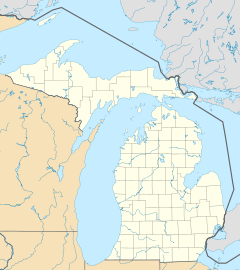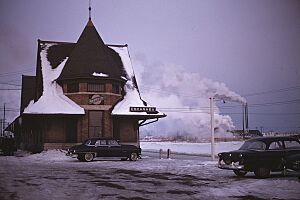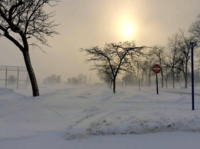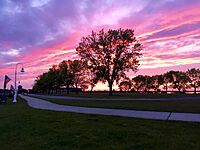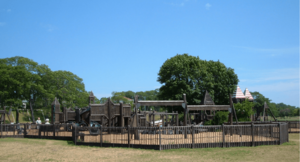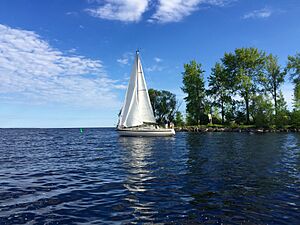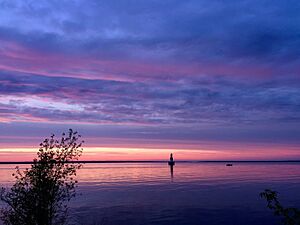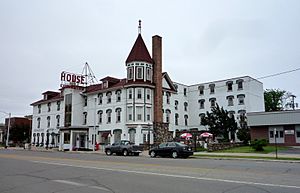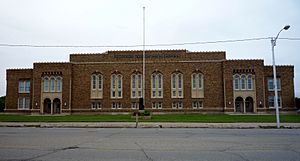Escanaba, Michigan facts for kids
Quick facts for kids
Escanaba, Michigan
|
|
|---|---|
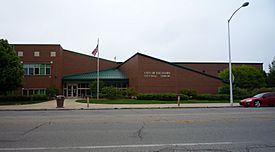
Escanaba City Hall and Library
|
|
| Nickname(s):
Esky
|
|
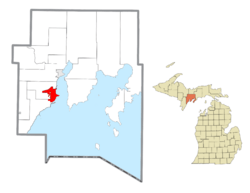
Location within Delta County
|
|
| Country | United States |
| State | Michigan |
| County | Delta |
| Incorporated | 1866 (village) 1883 (city) |
| Founded by | Eli Parsons Royce |
| Named for | Ojibwe for "land of the red buck" |
| Government | |
| • Type | Council–manager |
| Area | |
| • Total | 16.37 sq mi (42.39 km2) |
| • Land | 12.74 sq mi (33.01 km2) |
| • Water | 3.62 sq mi (9.38 km2) |
| Elevation | 607 ft (185 m) |
| Population
(2020)
|
|
| • Total | 12,450 |
| • Density | 976.85/sq mi (377.17/km2) |
| Time zone | UTC−5 (EST) |
| • Summer (DST) | UTC−4 (EDT) |
| ZIP Codes |
49829, 49894
|
| Area code(s) | 906 |
| FIPS code | 26-26360 |
| GNIS feature ID | 1619865 |
Escanaba (pronounced ES-kuh-NAH-buh), often called Esky, is a port city in Michigan. It is the main city of Delta County. Escanaba is located on Little Bay de Noc, which is part of Lake Michigan.
In 2020, about 12,450 people lived there. This makes it the third-largest city in Michigan's Upper Peninsula. The city and a nearby area called Escanaba Township are named after the Escanaba River. This river flows into Little Bay de Noc. The name "Escanaba" comes from the Ojibwa language.
Contents
History of Escanaba
Escanaba was once an Ojibwa village in the early 1800s. The Ojibwa are a Native American tribe who lived around the Great Lakes. The name "Escanaba" means "land of the red buck" in their language. Some people think it means "flat rock."
A surveyor named Eli P. Royce founded Escanaba as a port town in 1863. At first, the main businesses were cutting and selling lumber. Later, shipping iron ore became very important. During the American Civil War, Escanaba was a key port for sending iron ore and lumber to help the Union.
After the war, more iron ore was found nearby. This ore was used to make steel and other things needed for industries in the Midwest. Because of all the shipping, a lighthouse was built in 1868. The Sand Point Lighthouse helped guide ships safely into the harbor.
Escanaba Today
Escanaba continued to be an important place for shipping iron ore until 2017. The city also has a large paper mill. This mill was owned by Verso Corporation and is now owned by Billerud. It is one of the biggest employers in Escanaba.
Geography and Climate
Escanaba covers about 16.5 square miles (42.7 square kilometers). Most of this is land, but about 3.6 square miles (9.3 square kilometers) is water.
Weather in Escanaba
Escanaba has a humid continental climate. This means it has big changes in temperature between seasons. Summers are warm or hot and often humid. Winters are cold, sometimes very cold.
Escanaba is sometimes called the "banana belt" of Michigan's Upper Peninsula. This is because its winters are milder than other parts of the peninsula. Its location near Lake Michigan helps reduce the amount of lake-effect snow it gets.
| Climate data for Escanaba, Michigan (1991–2020 normals, extremes 1948–present) | |||||||||||||
|---|---|---|---|---|---|---|---|---|---|---|---|---|---|
| Month | Jan | Feb | Mar | Apr | May | Jun | Jul | Aug | Sep | Oct | Nov | Dec | Year |
| Record high °F (°C) | 55 (13) |
52 (11) |
70 (21) |
84 (29) |
91 (33) |
98 (37) |
99 (37) |
100 (38) |
96 (36) |
82 (28) |
71 (22) |
58 (14) |
100 (38) |
| Mean daily maximum °F (°C) | 25.6 (−3.6) |
27.8 (−2.3) |
36.7 (2.6) |
47.3 (8.5) |
60.3 (15.7) |
70.5 (21.4) |
76.6 (24.8) |
75.6 (24.2) |
67.6 (19.8) |
54.5 (12.5) |
42.2 (5.7) |
31.1 (−0.5) |
51.3 (10.7) |
| Daily mean °F (°C) | 16.9 (−8.4) |
18.0 (−7.8) |
27.3 (−2.6) |
38.4 (3.6) |
50.4 (10.2) |
60.7 (15.9) |
66.5 (19.2) |
65.4 (18.6) |
58.2 (14.6) |
45.5 (7.5) |
34.8 (1.6) |
23.8 (−4.6) |
42.2 (5.7) |
| Mean daily minimum °F (°C) | 8.1 (−13.3) |
8.2 (−13.2) |
17.9 (−7.8) |
29.4 (−1.4) |
40.6 (4.8) |
50.9 (10.5) |
56.4 (13.6) |
55.2 (12.9) |
48.9 (9.4) |
36.5 (2.5) |
27.4 (−2.6) |
16.4 (−8.7) |
33.0 (0.6) |
| Record low °F (°C) | −28 (−33) |
−30 (−34) |
−26 (−32) |
−1 (−18) |
23 (−5) |
30 (−1) |
38 (3) |
38 (3) |
25 (−4) |
19 (−7) |
−7 (−22) |
−23 (−31) |
−30 (−34) |
| Average precipitation inches (mm) | 1.18 (30) |
1.03 (26) |
1.64 (42) |
2.34 (59) |
3.32 (84) |
3.45 (88) |
2.90 (74) |
2.99 (76) |
3.21 (82) |
3.06 (78) |
2.35 (60) |
1.37 (35) |
28.84 (733) |
| Average snowfall inches (cm) | 13.7 (35) |
10.2 (26) |
6.1 (15) |
4.4 (11) |
0.0 (0.0) |
0.0 (0.0) |
0.0 (0.0) |
0.0 (0.0) |
0.0 (0.0) |
0.0 (0.0) |
2.3 (5.8) |
10.2 (26) |
46.9 (119) |
| Average precipitation days (≥ 0.01 in) | 9.2 | 7.0 | 7.4 | 9.6 | 12.0 | 12.6 | 10.4 | 10.4 | 10.8 | 12.6 | 9.0 | 8.6 | 119.6 |
| Average snowy days (≥ 0.1 in) | 5.5 | 3.6 | 2.5 | 1.3 | 0.0 | 0.0 | 0.0 | 0.0 | 0.0 | 0.1 | 1.6 | 3.5 | 18.1 |
| Source: NOAA | |||||||||||||
People of Escanaba
| Historical population | |||
|---|---|---|---|
| Census | Pop. | %± | |
| 1880 | 3,026 | — | |
| 1890 | 6,808 | 125.0% | |
| 1900 | 9,549 | 40.3% | |
| 1910 | 13,194 | 38.2% | |
| 1920 | 13,103 | −0.7% | |
| 1930 | 14,524 | 10.8% | |
| 1940 | 14,830 | 2.1% | |
| 1950 | 15,170 | 2.3% | |
| 1960 | 15,391 | 1.5% | |
| 1970 | 15,368 | −0.1% | |
| 1980 | 14,355 | −6.6% | |
| 1990 | 13,659 | −4.8% | |
| 2000 | 13,140 | −3.8% | |
| 2010 | 12,616 | −4.0% | |
| 2020 | 12,450 | −1.3% | |
| U.S. Decennial Census | |||
In 2010, there were 12,616 people living in Escanaba. Most residents were White (93.5%). About 2.6% were Native American. People of Hispanic or Latino background made up 1.2% of the population.
The average age in the city was 41.4 years old. About 21.4% of the people were under 18.
Culture and Fun
Escanaba and the western Upper Peninsula sometimes share more culture with Wisconsin than with the rest of Michigan.
Yooper Culture
Pasties are a popular food and a big draw for tourists. A pasty is a baked pastry filled with meat and vegetables. Many different groups of people in the area adopted pasties, and they are now a strong part of the local culture.
Arts and Shows
Escanaba has many places for arts and performances. These include the William Bonifas Fine Arts Center, The Waterfront Art Festival, and The Players de Noc. There are also musical groups like The Bay de Noc Choral Society and the Escanaba City Band.
Parks and Recreation
City Parks
- Ludington Park: This park stretches along three-quarters of a mile of the lake shore. It's one of the biggest city parks in Upper Michigan. You can find the Karas Band Shell here, where concerts are held in the summer. There's also a veterans memorial and a scenic gazebo.
- Harbor Hideout: Inside Ludington Park, this large wooden playground is 22,500 square feet. It has play areas that are easy for everyone to use, including those with disabilities.
- Kiwanis Musical Playground: This musical play area was added in 2018. It has instruments like a metallophone, chimes, and drums. All the equipment is designed to be accessible for people with disabilities.
Boating and Beaches
- Escanaba Yacht Club: Started in 1934, this club hosts many races and events for its members in the summer.
- Escanaba Municipal Beach: Located on Aronson Island, this beach is open from early June to mid-August. It has a beach house with changing rooms, restrooms, and showers. There's also a small playground and picnic area. You can often rent paddleboards and kayaks here.
- Aronson Island Boat Launch: You need a day-pass or seasonal permit to use this boat launch. There are limits on boat size and weight, but you can get a special permit for larger boats.
- North Shore Boat Launch: This boat launch is located on the Escanaba River.
Interesting Places to Visit
- The House of Ludington: This is a famous historic hotel in downtown Escanaba. It was first built in 1865 and rebuilt in 1883. People believe that a famous gangster, Al Capone, used tunnels under the hotel during the time when alcohol was illegal.
- Sand Point Lighthouse & Delta County Historical Museum: This lighthouse stopped being used in 1939. It has been fully restored to look like it did in the 1860s. It is listed on the National Register of Historic Places, which means it's an important historical site.
- U.P. Steam & Gas Engine Museum
- Carnegie Public Library (Escanaba Public Library)
- Hiawatha National Forest
- Days River Pathway or Days River Nature Pathway
- Escanaba Farmer's Market
Education
The public schools in Escanaba are run by Escanaba Area Public Schools. They include several elementary schools, a middle school, and a high school. In 2003, the historic junior high school building was fully renovated.
There is also a private school called Holy Name Catholic School. It teaches children from pre-school up to eighth grade.
Bay College is a public two-year college in Escanaba. It was founded in 1962. The college offers different two-year degrees and certificate programs. These include welding, public safety, business, and nursing.
Media
Escanaba has several local radio stations that play different types of music and news. You can also receive radio and television signals from nearby areas like Door County, Wisconsin.
In 1925, during a solar eclipse, a radio station from Chicago came to Escanaba. They wanted to study how the dimming sun affected radio signals.
City Features and Travel
Escanaba's Harbor Tower is an 18-story apartment building. It is the tallest building in Michigan's Upper Peninsula.
Getting Around
- US 2: This highway goes east to St. Ignace and the Mackinac Bridge, which is about 143 miles (230 km) away. It also goes west to Iron Mountain.
- US 41: This highway connects Escanaba to Marquette to the north (about 66 miles or 106 km). It also goes west to Powers and then south to Menominee.
- M-35: This road goes northwest through undeveloped areas to Gwinn. Going south, it follows the shore of Green Bay to Menominee.
- M-69: This road goes northwest to several small towns before ending at Crystal Falls.
Airport
Escanaba has its own airport, Delta County Airport (KESC). It has daily flights to Detroit and Minneapolis.
Buses
Indian Trails provides daily bus service. You can take a bus from Escanaba to places like St. Ignace, Ironwood, Michigan, Hancock, Michigan, and Milwaukee, Wisconsin.
Railroads
Escanaba has a long history with railroads. Many different railroad companies used to serve the area. They were important for shipping lumber and iron ore. Some railroads also offered passenger service. Today, two main railroad companies, the E&LS and CN, still operate in Escanaba. CN owns the last two rail yards in the city, including the Escanaba Ore Docks.
Famous People from Escanaba
- Tom Bissell, an author
- Kevin Chown, a bass player
- Fahey Flynn, a television news reader
- Karla M. Gray, Montana's first female chief justice
- Becky Iverson, a professional golfer
- Nelson Ludington, a settler who helped name the city
- Willard A. Saunders, a Rear admiral in the U.S. Navy
- "Roaring Dan" Seavey, a Great Lakes pirate
- Johnny Seymour, a racing driver
- Kevin Tapani, a baseball player
- Jack Tower, a racing driver
- Chauncey W. Yockey, a Wisconsin State Assemblyman
Images for kids
-
The Sand Point Lighthouse is on the National Register of Historic Places.
See also
 In Spanish: Escanaba (Míchigan) para niños
In Spanish: Escanaba (Míchigan) para niños


